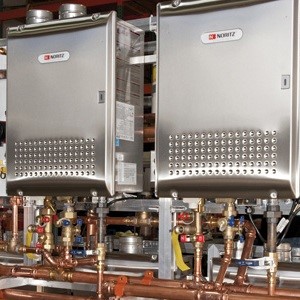Facilities Resource Group’s tankless water heater rack assemblies are designed and fabricated at the company’s Grandville, Mich., headquarters and then driven to restaurants for installation. Photos by Frank Monkiewicz Photography and Kevin Bewick, People, Places & Things Photographics
Hot water is the lifeblood of any restaurant kitchen operation. Lacking a sufficient and ready supply at the correct temperatures, as prescribed by local health authorities, facility management usually has no choice but to lock the doors until the problem is fixed.
Despite the vital importance of hot water, delivering the right quantities to the right outlets at the right temperatures – especially during operational peaks – is an anxious, uphill battle for many managers. Whether the culprit is undersized equipment, poor installation or inadequate maintenance, many restaurants routinely endure a tense can’t-live-with/can’t-live-without relationship with their commercial water heaters.
But an innovative approach to restaurant water heating that melds all the necessary components into a single, prefabricated, ready-to-install package is achieving positive results for a growing number of proprietors who have experienced improved system performance and longevity, as well as energy savings.
Grandville, Mich.-based Facilities Resource Group engineers a rack system that combines one to six Noritz America condensing tankless water heaters (Energy Factor of 0.93) with isolation valves, system and pump controllers, surge protectors, and even recirculation pumps and expansion tanks as needed – all mounted to a mobile aluminum frame and finished off with insulated copper tubing.
The true breakthrough was FRG’s decision to leverage the inherent advantages of multiple tankless water heaters into a turnkey service program catering specifically to the rigorous demands of quick-service and casual-dining restaurant chains. FRG designs and fabricates the racks, ships them in FRG trucks, personally participates in the installation (with a qualified local contractor) and coordinates post-installation service work.
The rationale for this turnkey package is based on the key role hot water plays in a restaurant’s daily operation and the impact it can have on the establishment’s long-term viability.
“I have seen restaurant chains spend thousands of dollars to ship cooking equipment cross-country overnight just to prevent any loss of business on an upcoming busy day,” FRG Director of Engineering Ben Wirick states. “These operators are concerned about not just the lost dollars and cents they can count, but also the less-tangible losses. If they must shut down for even a half day, will disappointed customers opt for a restaurant down the street and never come back? They don’t want to take that chance.”
In addition to affecting operations in the back of the restaurant, a lack of hot water is a health concern for customers.
“Not having the ability to be sanitary is a critical violation,” Wirick says. It’s not only for employees in the back of the house, but the guests in the front of the house that use the restrooms. There have been Norovirus outbreaks that have closed restaurants and made a bunch of people sick with some nasty stuff. It connects back to people not washing their hands and going back into the restaurant.”
Since launching its comprehensive service in 2008, FRG has designed, built and installed approximately 800 tankless water heater rack systems in 200 corporate and franchised restaurants nationwide. Its most prominent accounts include Texas Roadhouse (35 new installations and 160 retrofits), Cracker Barrel and Pepper Dining Inc., which owns and operates 106 Chili’s locations in 10 Northeastern states (38 retrofits).
Scott Amerault, PDI’s director of facilities, turned to FRG for help in February 2010. Amerault is responsible for keeping hot water flowing at all PDI facilities.
“I handled everything from finding the product and hiring the installer to coordinating the installation with our local restaurant team,” he explains of his pre-FRG relationship responsibilities.
Amerault also had the unenviable task of summoning the installer back to the restaurant if there was a problem.
“In some cases, it was a nightmare of chasing people down and dealing with a lot of finger-pointing,” he says. “With FRG, I make one phone call and they go to work with my local team to solve our problems. Working with FRG, I have never needed to close a restaurant equipped with a tankless water heater.”

